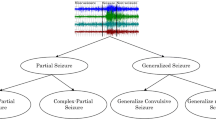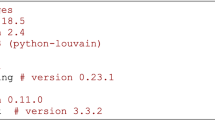Abstract
Temporal synchronization of neuronal activity plays an important role in various brain functions such as binding, cognition, information processing, and computation. Patients suffering from disorders such as Alzheimer’s disease or schizophrenia show abnormality in the synchronization patterns. Electroencephalography (EEG) is a cheap, non-invasive, and easy-to-use method with fine temporal resolution. Modern multichannel EEG data are increasingly being used in brain studies. Traditional approaches for identifying synchronous activity in EEG are through univariate techniques such as power spectral density or bivariate techniques such as coherence. In this paper, we review two methods for synchronization analysis within multivariate time series. One method, denoted by multivariate state-space synchronization-estimator, calculates the generalized synchronization based on the shrinking of the embedding dimension in the state-space. The other method, denoted by multivariate phase synchronization-estimator, considers phase of the signals and calculates the mean coherency within multivariate phases. Their effectiveness is assessed on both simulated data and real EEGs.




Similar content being viewed by others
References
Fenton GW, et al. EEG spectral analysis in schizophrenia. Br J Psychiatry. 1980;136:445–55.
Knyazeva MG, et al. Alpha rhythm and hypofrontality in schizophrenia. Acta Psychiatr Scand. 2008;118(3):188–99.
Adler G, Brassen S, Jajcevic A. EEG coherence in Alzheimer’s dementia. J Neural Transm. 2003;110(9):1051–8.
Hogan MJ, et al. Memory-related EEG power and coherence reductions in mild Alzheimer’s disease. Int J Psychophysiol. 2003;49(2):147–63.
Jeong J. EEG dynamics in patients with Alzheimer’s disease. Clin Neurophysiol. 2004;115(7):1490–505.
Dauwels J, Vialatte F, Cichocki A. Diagnosis of Alzheimer’s disease from EEG signals: where are we standing? Curr Alzheimer Res. 2010;7(6):487–505.
Lee S-A, Spencer DD, Spencer SS. Intracranial EEG seizure-onset patterns in neocortical epilepsy. Epilepsia. 2000;41(3):297–307.
Mormann F, et al. Mean phase coherence as a measure for phase synchronization and its application to the EEG of epilepsy patients. Physica D. 2000;144:358–69.
Moazami-Goudarzi M, et al. Enhanced frontal low and high frequency power and synchronization in the resting EEG of parkinsonian patients. NeuroImage. 2008;41(3):985–97.
Dauwels J, et al. A comparative study of synchrony measures for the early diagnosis of Alzheimer’s disease based on EEG. NeuroImage. 2010;49(1):668–93.
Gray CM, Singer W. Stimulus-specific neuronal oscillations in orientation columns of cat visual cortex. Proc Natl Acad Sci USA. 1989;86:1698–702.
Singer W. Neuronal synchrony: a versatile code for the definition of relations? Neuron. 1999;24(1):49–65.
Gray CM, et al. Oscillatory responses in cat visual-cortex exhebit inter-columinar synchronization which reflects global stimulus properties. Nature. 1989;338(6213):334–7.
Uhlhaas PJ, Singer W. Neural synchrony in brain disorders: relevance for cognitive dysfunctions and pathophysiology. Neuron. 2006;52(1):155–68.
Koenig T, et al. Decreased EEG synchronization in Alzheimer’s disease and mild cognitive impairment. Neurobiol Aging. 2005;26(2):165–71.
Jalili M, et al. Dysconnection topography in schizophrenia with state-space analysis of EEG. PLoS ONE. 2007;2(10):e1059.
Spencer K, et al. Abnormal neural synchrony in schizophrenia. J Neurosci. 2003;23(19):7407–11.
Just MA, et al. Cortical activation and synchronization during sentence comprehension in high-functioning autism: evidence of underconnectivity. Brain. 2004;127(8):1811–21.
Jelic V, et al. Quantitative electroencephalography power and coherence in Alzheimer’s disease and mild cognitive impairment. Dement Geriatr Cogn Disord. 1996;7(6):314–23.
Merrin E, Floyd T, Fein G. EEG coherence in unmedicated schizophrenic patients. Biol Psychiatry. 1989;25(1):60–6.
Jalili M. Collective behavior of interacting locally synchronized oscillations in neuronal networks. Commun Nonlinear Sci Numer Simul. 2012;17:3922–33.
Kreuz T, et al. Measuring multiple spike train synchrony. J Neurosci Methods. 2009;183(2):287–99.
Ford J, et al. Reduced communication between frontal and temporal lobes during talking in schizophrenia. Biol Psychiatry. 2002;51(6):485–92.
Hoffman R, et al. EEG coherence of prefrontal areas in normal and schizophrenic males during perceptual activation. J Neuropsychiatry Clin Neurosci. 1991;3(2):169–75.
Pereda E, Quiroga RQ, Bhattacharya J. Nonlinear multivariate analysis of neurophysiological signals. Prog Neurobiol. 2005;77:1–37.
Audrino F, Buhlmann P. Synchronizing multivariate financial time series. Zurich: ETH Zurich; 2001.
Carmeli C, et al. Assessment of EEG synchronization based on state-space analysis. NeuroImage. 2005;25(2):339–54.
Knyazeva MG, et al. Topography of EEG multivariate phase synchronization in early Alzheimer’s disease. Neurobiol Aging. 2010;31:1132–44.
Righero M, De Feo O, Biey M. A cooperation index based on correlation matrix spectrum and Renyi entropy. In: European conference on circuit theory and design. 2009. p. 466–469.
Koenig T, et al. Decreased functional connectivity of EEG theta-frequency activity in first-episode, neuroleptic-naıve patients with schizophrenia: preliminary results. Schizophr Res. 2001;50(1–2):55–60.
Wackermann J. Beyond mapping: estimating complexity of multichannel EEG recordings. Acta Neurobiol Exp. 1996;56:197–208.
Allefeld C, Bialonski S. Detecting synchronization clusters in multivariate time series via coarse-graining of Markov chains. Phys Rev E. 2007;76:066207.
Boccaletti S, et al. The synchronization of chaotic systems. Phys Rep. 2002;366(1–2):1–101.
Kantz H, Schreiber T. Nonlinear time series analysis. 2nd ed. Cambridge: Cambridge University Press; 2004.
Carmeli C. Assessing cooperative behavior in dynamical networks with applications to brain data. Lausanne: Ecole Polytechnique Federal de Lausanne; 2006.
Strang G. Introduction to linear algebra. 3rd ed. Wellesley: Cambridge Press; 2003.
Rosenblum MG, Pikovsky AS, Kurths J. Phase synchronization of chaotic oscillators. Phys Rev Lett. 1996;76(11):1804–7.
Hahn SL. Hilbert transforms in signal processing. London: Artech House Publishers; 1996.
Quiroga R, et al. Performance of different synchronization measures in real data: a case study on electroencephalographic signals. Phys Rev E. 2002;65:041903.
Strogatz SH. From Kuramoto to Crawford: exploring the onset of synchronization in populations of coupled oscillators. Physica D. 2000;143(1–4):1–20.
Kuramoto Y. Chemical oscillations, waves, and turbulence. New York: Dover; 2003.
Le Van Quyen M, et al. Comparison of Hilbert transform and wavelet methods for the analysis of neuronal synchrony. J Neurosci Methods. 2001;111:83–98.
David O, Cosmelli D, Friston KJ. Evaluation of different measures of functional connectivity using a neural mass model. NeuroImage. 2004;21:659–73.
Rössler OE. An equation for continuous chaos. Phys Lett A. 1976;57(5):397–8.
Quarteroni A, Sacco R, Saleri F. Numerical mathematics. Berlin: Springer; 2000.
Benjamini Y, Hochberg Y. Controlling the false discovery rate—a practical and powerful approach to multiple testing. J R Stat Soc Series B Stat Methodol. 1995;57(1):289–300.
Rickham PP. Human experimentation. Code of Ethics of the World Medical Association. Declaration of Helsinki. Br Med J. 1964;2(5402):177.
Nunez P, Srinivasan R. Electric fields of the brain: the neurophysics of EEG. 2nd ed. New York: Oxford University Press; 2006.
Knyazeva MG, et al. Psychogenic seizures and frontal disconnection: EEG synchronisation study. J Neurol Neurosurg Psychiatry. 2011;82(5):505–11.
Srinivasan R, et al. Spatial sampling and filtering of EEG with spline Laplacians to estimate cortical potentials. Brain Topogr. 1996;8:355–66.
Nunez P, et al. EEG coherency I: statistics, reference electrode, volume conduction, Laplacians, cortical imaging, and interpretation at multiple scales. Electroencephalogr Clin Neurophysiol. 1997;103(5):499–515.
Acknowledgments
The author would like to thank Dr. Maria G. Knyazeva for EEG recording and preprocessing in her lab and Homa Babai for carefully editing the manuscript.
Author information
Authors and Affiliations
Corresponding author
Rights and permissions
About this article
Cite this article
Jalili, M. Multivariate Synchronization Analysis of Brain Electroencephalography Signals: A Review of Two Methods. Cogn Comput 7, 3–10 (2015). https://doi.org/10.1007/s12559-013-9213-4
Received:
Accepted:
Published:
Issue Date:
DOI: https://doi.org/10.1007/s12559-013-9213-4




